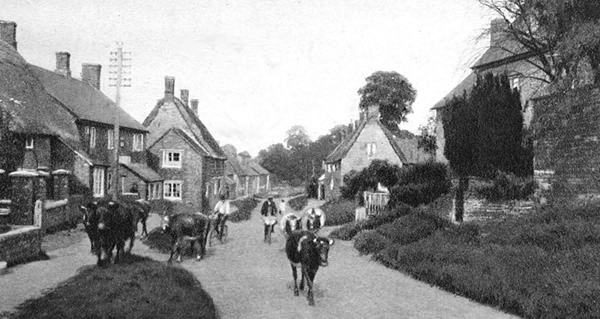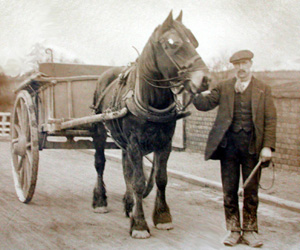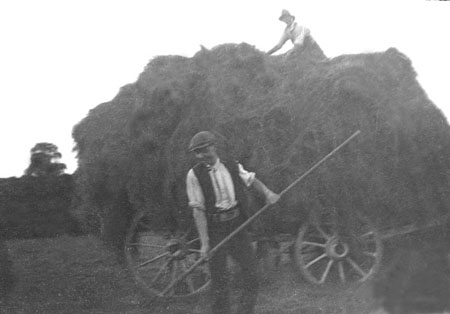
Cattle in Great Street 1929
FARMING IN SULGRAVE BEFORE THE 1939-45 WAR
(Back to Chapter 1 Index)
In the mid 1930s, the size of farms varied from a few acres, mainly rented, to the larger farms of some 400 acres. Small farms were supported by hand-milking cows and rearing the calves produced from dairy cows. The larger farms had more livestock, including milking-cows, beef-type cattle, sheep and a few pigs. Poultry, including hens, geese, turkeys, guinea fowl and bantams were common to most farms. Arable acreage produced corn for animal feeding and human consumption, as well as straw for animals, and thatch for ricks of hay and houses in the village. The crops were wheat, oats, a little barley, field beans, a few peas and vetches. Root crops were grown; mangold for cattle feeding (also wine making), swedes, turnips and potatoes for animals and humans. A lot of hay was made for animals to survive the more severe winters, for the greater part of the parish acreage was grassland. At the time of shortage of grazing, small herds of cows used to graze the grass roadside verges and village greens.

Cattle in Great Street 1929
During these years many horses were used for nearly all of the heavy work of farms, for riding, transportation and pulling wagons, carts, floats, traps, gigs, tubs and governess carts. Many hunters were used for hunting with the local Grafton and Bicester and Warden Hill hounds.

Bert Wootton at Culworth Station with builder's
horse and cart, early 1930s.
Very few tractors existed until the mid and late 1930s. When the 2nd World War started, in an attempt to become more self-sufficient, the Government directed farmers to plough the grassland to increase the production of grain. Farmers had to mechanise to get the work done. Tractors were bought, with ploughs, cultivators, disc harrows, zig-zag harrows, drag harrows, rollers, crushers and binders for cutting corn and tying it into sheaves, ready to be stacked into ricks when dry and matured. For the first time trailers were used to carry produce and elevators were introduced for conveying hay and sheaves onto the ricks. Corn threshing machines were more common as a lot of ricks of corn had to be threshed.

Haymaking in the 1920s (Bill Branson)
The first combine harvesters appeared during the war years, imported from America by the War Agricultural Executive Committee. They were hired by farmers as a further means of increasing efficiency in the absence of farm workers.
During these years problems arose such as weeds overcoming crops, and chemicals were used, first of all in powder form, to control some of the problem weeds, like the charlock, poppies, thistles and cleavers.
